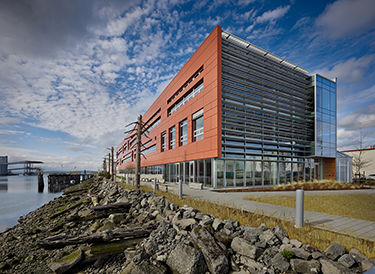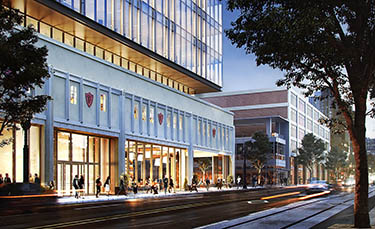|
Subscribe / Renew |
|
|
Contact Us |
|
| ► Subscribe to our Free Weekly Newsletter | |
| home | Welcome, sign in or click here to subscribe. | login |
Construction
| |
 |
March 29, 2018
Climate change is making resilience a more urgent design priority
Perkins+Will

Tyner
|
Over the past few decades, there has been steady progress in the building industry toward producing projects that are environmentally sensitive and energy efficient.
This movement is spearheaded by the global efforts of the United Nations Intergovernmental Panel on Climate Change, regulatory agencies like the Environmental Protection Agency and the Department of Energy, and cities, states and companies.
Standards such as the U.S. Green Building Council's LEED rating system and the Living Building Challenge have become synonymous with sustainability. Their fundamental goals are to sustain natural resources, promote occupant health and reduce life-cycle waste and pollution to safeguard prosperity and opportunity for future generations.
Despite the positive influence of the sustainability movement, it is imperative to look more broadly at how the work we create connects to the systems we are part of. Resilient design, with its emphasis on withstanding and recovering from the impact of shocks and stressors, is the natural evolution of sustainability. Sustainability relies on resilience.
Designing for resilience
Resilience is often confused with sustainability because there are numerous overlapping components: flexibility, adaptability, energy efficiency, health, material reuse and conservation, to name a few. Designing for resilience involves assessing social, economic and environmental vulnerabilities, then implementing design responses to enhance system stability.
For example, what if a hospital could be designed to remain operational — and energy- and water-self-sufficient — in the event of a disaster? What if an office tower provided safe shelter, food, water and emergency supplies for days after an earthquake?
Could distributed clean power sources reduce greenhouse gas emissions, lower consumer cost and ensure critical operations when grid services are disrupted? Can rooftop gardens provide employment opportunities and fresh food sources?
Dangers ahead
There are numerous issues creating an urgent need for a holistic design approach. Pollution continues to accelerate biodiversity loss through atmospheric degradation and contamination of land and water.
The frequency and severity of natural disasters is on the rise due to climate change. Exponential population growth means more people are impacted by climate-related displacement, economic disparity and competition for finite resources.
In the Pacific Northwest, it is essential to prepare for shocks such as earthquakes and flooding in design planning. We are experiencing warmer and drier summers that affect thermal comfort, agriculture and ecology. Recent Canadian and eastern Washington forest fires resulted in weeks of poor air quality. Projections forecast more severe storms and rising waters.
A recent University of Washington study highlights the disparity in life expectancy between higher- and lower-income neighborhoods. Resilience planning should include policy and strategies that bolster all demographics. Designs must respond not only to the threat of acute shocks but also to issues posed by chronic stressors such as income inequity, aging infrastructure, and access to transportation, food and water.
Taking action
In the U.S., there are cities, states, communities, corporations, universities and institutions that are making resilience planning a priority.
Examples of these efforts include the Department of Housing and Urban Development's National Disaster Resilience Competition, World Bank's Urban Risk Assessment and the Rockefeller Foundation's 100 Resilient Cities program. Seattle is currently formulating its strategic plan based on a resilience workshop held in 2016.
In 2014, Perkins+Will, along with the Institute for Market Transformation to Sustainability, began development of RELi. This comprehensive action list was created to assist architects, city planners, developers, governments and businesses to design buildings, communities and neighborhoods to better withstand and recover from shocks and stressors. In a report prepared for the Energy, Kresge and Barr foundations, the Meister Consultants Group identified RELi as the only standard holistically addressing facilities and communities, including social vulnerability.
At Greenbuild 2017, USGBC formally announced its adoption of RELi. This means the standard will become a global rating system, similar to but independent from LEED.
Credits unique to the standard include adaptive design for extreme rain, sea level rise and storm surge. RELi also supports robust systems with credits that require projects to participate in or establish organizations that build community cohesion, and social and economic vitality. RELi is currently being used by pilot projects across the country.
Local examples
Designs that are regenerative and replenish essential systems contribute to resilience. For the Center for Urban Waters in Tacoma, Perkins+Will looked for ways to reintroduce biodiversity and restore the area's original habitat, which served as an osprey migratory path before becoming heavily industrialized.
Tree snags for bird perching were installed along the Thea Foss Waterway and large trees were anchored in the water along the bank to create shaded areas for fish and wildlife. Several weeks after the building was complete, users saw an osprey perched on one of the snags, signifying that ecological restoration had begun.
Reducing reliance on grid source energy and incorporating distributed power systems promotes resilience. Perkins+Will's design for 400 Westlake in Seattle's South Lake Union neighborhood is participating in the city's Living Building Pilot Program.
The project incorporates self-sufficiency through on-site energy production and storage, providing emergency lighting for 10 percent of the building and refrigeration needs for one week. In addition, the project is committed to net-positive energy, which means it will generate more electricity than it needs to operate.
Since the roof area available for solar panels is not sufficient to produce all of the building's power, additional panels will be installed at an off-site location. This strategy, called scale jumping, enables others to benefit from distributed power.
Inspiring change
Rating systems are successful when they focus our aspirations and influence related industries to value environmental stewardship. Green design minimizes our impact on the Earth, however even the most sustainable projects are susceptible to shocks and stressors.
Resilient design, including innovative actions developed in RELi, challenges us to be proactive and inclusive as we address social, economic and environmental vulnerabilities. By embracing our diversity and interconnectivity, we can inspire an industry transformation that fortifies sustainability.
Chris Tyner is an associate with the Seattle office of global architecture and design firm Perkins+Will. Tyner is one of 28 RELi-accredited professionals worldwide; three are with the Perkins+Will Seattle office.
Other Stories:
- Let’s make buildings people can still use after a disaster
- New green rating systems go way beyond LEED
- How cleaner indoor air makes for healthy workers and a healthier bottom line
- Cheap solar energy won't end the need for deep-green buildings
- To meet green goals, cities must grow more strategically
- Asphalt: the go-to material for green paving projects
- We designed our own net-zero office — and you can, too
- SPU remodel shows even industrial buildings can be green
- Why we can’t reach our emissions goals without tracking embodied carbon




